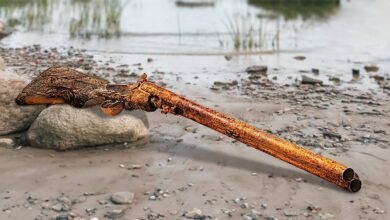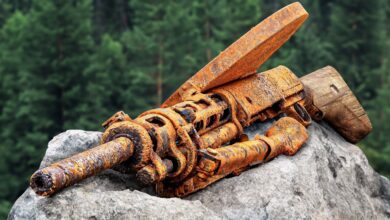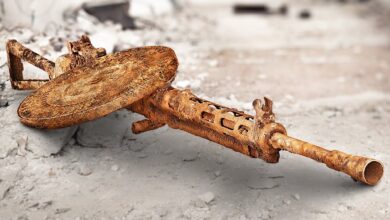Restoration of the Old ZB 30 Machine Gun: A Journey into Historical Precision
The ZB 30, designed by Czech engineer Josef Václav Macha in the early 1930s, is one of the more iconic machine guns of its time. It has a storied history, seeing service in various conflicts and influencing the design of other firearms, particularly in the development of the German MG34. As an integral part of many military forces during its service life, the ZB 30 was eventually replaced by more modern weapons, but its historical significance remains undeniable.
Restoring the ZB 30 machine gun is a delicate process that combines historical preservation, mechanical craftsmanship, and a deep respect for the firearm’s legacy. This article delves into the intricacies of ZB 30 restoration, from sourcing parts to the technical work needed to bring these remarkable pieces of history back to life.
A Brief History of the ZB 30
Introduced in 1930, the ZB 30 was a gas-operated, air-cooled, belt-fed, medium machine gun that featured an innovative design for its time. It was chambered for the 7.92×57mm Mauser cartridge, which was standard in many European military rifles. The ZB 30 saw widespread use during the interwar period and into the early stages of World War II, with notable usage by the Czechoslovak Army, Poland, and other nations.
Its most significant contribution was its technical prowess, especially its smooth, consistent feeding mechanism and modular design. Though the ZB 30 was eventually eclipsed by other machine guns in the years following its service, it left a lasting impact on the development of firearms worldwide.
The Importance of Restoration
Restoring a ZB 30 machine gun is not just about repairing mechanical issues. It’s about preserving a piece of history. Many ZB 30s were either lost during wartime, discarded due to damage or age, or, in some cases, deliberately destroyed after conflicts. As a result, the number of intact ZB 30s has dwindled, making restoration efforts all the more crucial.
Restoration involves not only mechanical restoration but also the aesthetic details—recreating original features such as the finish, markings, and overall condition of the gun to retain its historical accuracy. Whether it’s a private collector or a museum restoring a ZB 30, the goal is to maintain its integrity while ensuring that it remains a functional and safe piece of machinery.
Challenges in ZB 30 Restoration
Restoring the ZB 30 presents several challenges, largely due to the rarity of original parts and the complexity of the machine gun’s design. Some of the most notable challenges include:
1. Sourcing Parts
The ZB 30 is over 90 years old, which means original parts are difficult to find. Many ZB 30s were used extensively and worn down during service, and as these weapons were replaced by more modern models, spare parts became increasingly scarce. In some cases, parts may need to be fabricated from scratch by highly skilled machinists who can replicate original components with high precision.
2. Wear and Tear
Like any piece of military equipment, the ZB 30 faced years of harsh use during its operational lifetime. It could suffer from issues like rust, worn-out springs, cracked receivers, or broken components. Restoration requires careful examination of each part to ensure it can be repaired, restored, or replaced with parts that maintain the firearm’s original performance.
3. Restoring the Woodwork
The ZB 30 had wooden components, including the stock and handguard. These wooden pieces are often damaged due to prolonged exposure to the elements and heavy use. Restoring the wood involves carefully sanding, reshaping, and re-finishing the wood to match its original condition. Some restorations also call for recreating the original checkering pattern that was a hallmark of the ZB 30’s design.
4. Preserving Original Markings
Each ZB 30 was stamped with specific serial numbers, factory markings, and unit insignia that denote its authenticity. Part of the restoration process is ensuring that these markings are preserved or replicated as closely as possible, which is vital for collectors and historians. This attention to detail is key for maintaining the historical value of the machine gun.
The Restoration Process
Restoring the ZB 30 is a meticulous and multi-step process. Below is an overview of the typical steps involved in a restoration:
1. Initial Assessment and Disassembly
The first step in restoring any firearm is to conduct a thorough inspection. This involves disassembling the machine gun down to its component parts, inspecting the barrel, receiver, trigger mechanism, bolt, feed system, and other internal components for any signs of wear, damage, or corrosion. Documentation of the condition of each part is essential for both the restoration process and historical record.
2. Cleaning and Repairing Parts
After disassembly, the cleaning process begins. Parts are cleaned to remove dirt, oil, rust, and other contaminants. This cleaning may involve using ultrasonic baths, sandblasting, or other specialized methods depending on the condition of the parts. Any worn or damaged parts are then repaired or replaced with as-original components, if available.
3. Re-manufacturing Components
For components that are beyond repair or simply no longer available, skilled craftsmen may need to fabricate replacements. This process requires highly specialized knowledge of firearms engineering. Some parts may require advanced machining and heat treatment to match the specifications of the original ZB 30 parts.
4. Wood Restoration
The woodwork is often the most time-consuming part of restoring the ZB 30. Cracked or damaged stocks and handguards must be carefully repaired. If the wood is too damaged, new wood must be selected, shaped, and stained to match the original finish. The final result should have the same appearance and feel as the original.
5. Reassembly and Testing
After all parts have been cleaned, repaired, or replaced, the machine gun is carefully reassembled. Each component must be tested for fit, function, and safety. Once reassembled, the gun undergoes thorough testing to ensure it performs correctly, cycling ammunition properly and firing safely. During testing, adjustments may be made to ensure smooth operation.
6. Final Finishing and Detailing
Once the ZB 30 is fully operational, it undergoes final cosmetic work. This can include refinishing the metal parts to their original blued or parkerized finish, reapplying the original markings and serial numbers, and ensuring the gun looks as close to its original condition as possible. The final result is a historically accurate and functional firearm.
Conclusion
Restoring a ZB 30 machine gun is a labor-intensive yet rewarding process that requires a deep understanding of both history and firearm mechanics. For collectors, military historians, and firearms enthusiasts, bringing these iconic weapons back to life ensures that future generations can appreciate their historical significance and technical innovations.
The restoration of the ZB 30 is not only about repairing a piece of military equipment but also about honoring the legacy of a weapon that played a significant role in shaping modern firearm design. Each restoration project helps preserve a tangible piece of history, ensuring that the ZB 30’s legacy endures for decades to come.





